Project Solanum - Infrared Cinematography with Full Spectrum Conversion and IR Chrome
Project Solanum is a climate fiction project in development: Switzerland in the year 2064. Climate change has turned the entire food supply upside down. Strong-willed crop scientist Hiwot opposes all-powerful corporations and radicalized activism to prevent the threat of world hunger.
Contribute to our story: www.projectsolanum.community
Project Solanum’s development has always focused on feasibility. The science fiction project will be made in Switzerland with local filmmakers, which is why we set out early to find techniques that are realistic for local budgets and at the same time promise high production value. Thanks to the support of Migros Culture Percentage Story Lab, Foto Video Zumstein / zumirent.ch and Kolari, we were able to test filming in the infrared range already in the development process and thus create our own visual language for the story. The results are fantastic images from a world in which nature takes on a completely different look and lets us experience directly that color is a relative concept. To be honest, none of us in the team managed to fully understand the underlying principle until the very end. But first things first.
In order to be able to record digital footage in the infrared range, you first need a camera that can also capture light outside of the visible spectrum. This means that ultraviolet and infrared rays also reach the camera sensor and are included in the recording. This technology has been used in photography for a long time and there is a lot of information and services available. Thanks to Kolari, we now have a supplier that also offers the necessary mechanical modification for digital cameras, although there are only a few examples of its application to date. During conversion, a piece of glass in front of the camera sensor is removed, which normally ensures that the light spectrum is limited to the visible part.
For our purposes, we sent a Blackmagic Pocket Cinema Camera 6K to Kolari and had it modified. In the end, you don’t actually lose anything with the modification, because the so-called hot mirror, i.e. the IR-UV cut filter, can simply be remounted as a screw-in or clip-in filter to get the original function back.
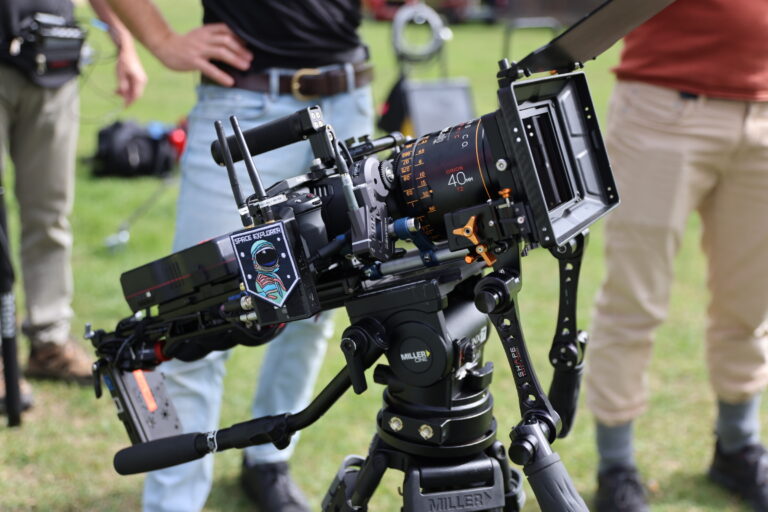
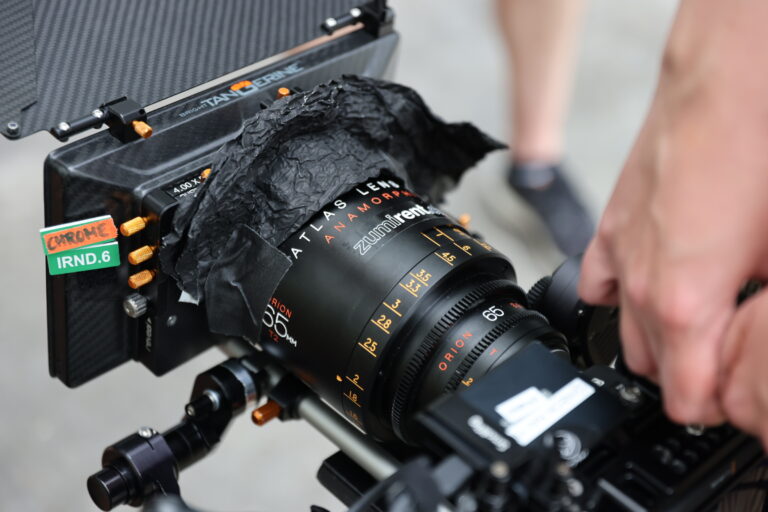
However, as an extended spectrum of light is now captured by the camera without a hot mirror, there are countless ways in which this can be used creatively. There are various filters to try out. Some filters change the image so much that it looks quite extreme, while others require you to swap the color channels after shooting. In this way, you can achieve an attractive image of landscapes and architecture, but as the skin tones also change when the channels are swapped, these variants were not interesting for our film project. We tested two filters in detail: IR-Chrome and 550Nm. Both were provided by Kolari and can be purchased in the Foto Video Zumstein store. The IR-Chrome filter was our first choice, as it changes the green of the vegetation without irrevocably shifting the skin tones or the blue of the sky. As it turns out, IR-Chrome is a good entry-level filter for the technique. Namely because it is almost WYSIWYG, i.e. “what you see is what you get”.
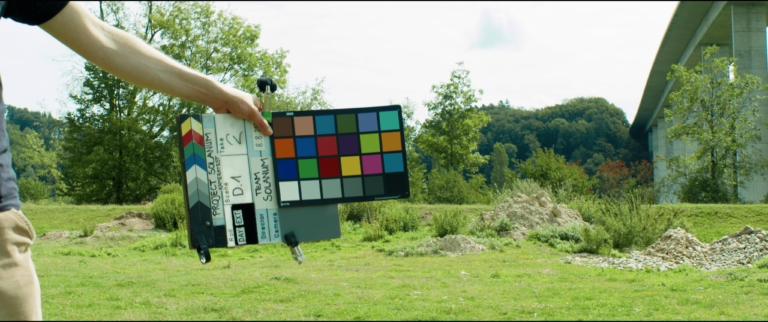
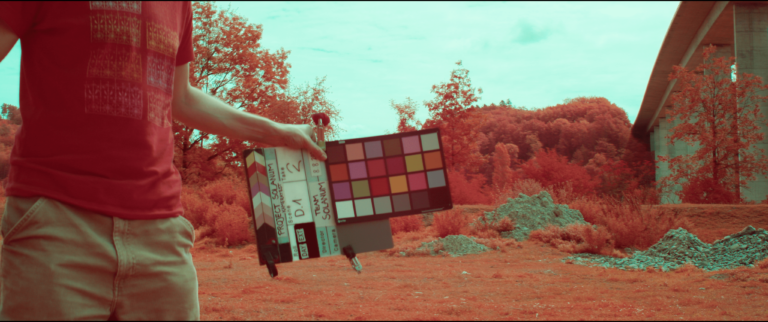
But it’s not that simple after all. The IR Chrome effect not only changes the landscape, but also everything else that interacts with the infrared wavelength range. Namely the costumes of the actresses and some props. Make-up doesn’t seem to be affected, except for artificial blond hair, which suddenly turns bright red, even if it has been dyed with another color. That’s why we tried out textiles extensively before the actual test in order to produce a costume that behaves as we want and expect it to under IR conditions.
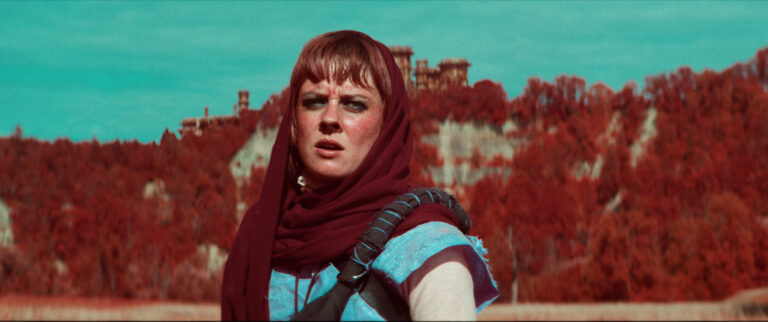
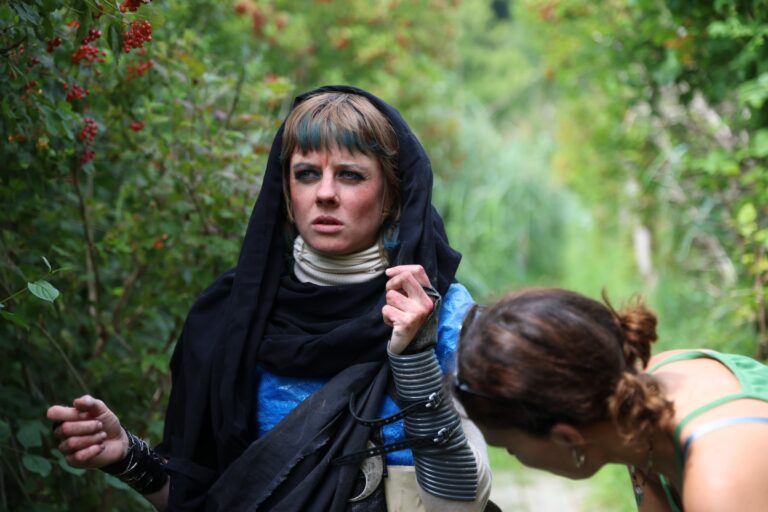
No object, no material, no surface behaves in the same way. We could never – and still cannot – say with absolute certainty how a color or material will behave in the IR image. The color black, for example, can either emit infrared or not, depending on the processing of the object or textile. During our material tests, which we consistently carried out on site in the stores where we bought the props and textiles, we were always very surprised. In a series of black ropes several types turned red and only one rope glowed in its original black. The camera stayed with the costume designer during the entire costume creation process so that she could see live, so to speak, how the material behaved.
On the film set we had to take extra time to rethink our compositions. Good monitoring was an important tool. We therefore decided to work with a wireless video link and the Atomos Sumo monitor from zumirent to have a large control monitor that we could trust and which we could feed a so-called LUT, or look-up table, to color-correct the IR Chrome image to a reference range. And the journey with IR-Chrome wasn’t quite over with the shoot. A lot of things we only discovered in post-production.
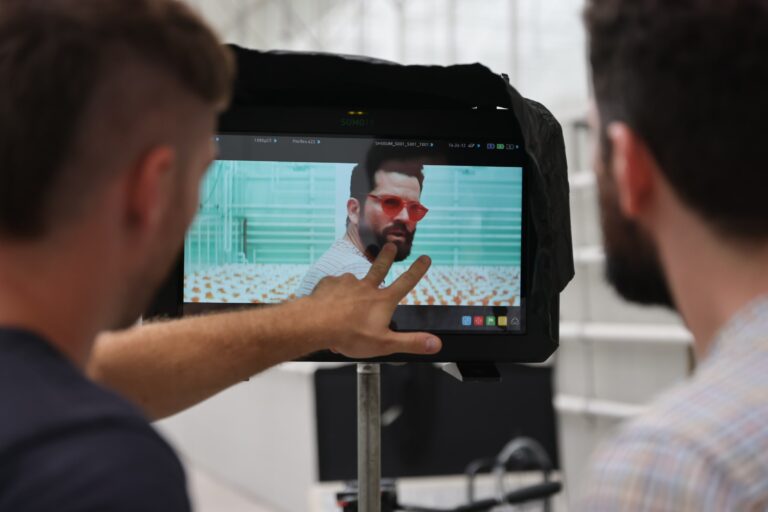
A first, important finding revolves around so-called IR pollution. A factor that is relevant even without IR-Chrome, namely when using ND filters in sunlight that do not have IR protection. The more you filter out the visible spectrum without also filtering out the IR at the same time, the more IR takes over the image. The result: the image is dyed red, especially in the shadows. For the use of IR Chrome, it was therefore all the more important to use high-quality IRNDs, which we were provided with by zumirent. Non-IRND filters are completely unusable in combination with IR Chrome.

There is also the phenomenon of IR overload. Even when using IRND, if IR light hits the subject from all directions, the IR component is still so high that the entire image and, for example, the skin tones only appear reddish. It is therefore worth carefully selecting the location, the position of the subject and the camera in order to be able to control the proportion of IR.
One factor that had less to do with the extended spectrum and more with our genre was the choice of lens. We wanted to shoot anamorphic, which is why we chose the Atlas Orion from zumirent. Although they produce a beautiful, characteristic and soft image, they also produce a lot of aberrations and struggle to retain contrast, especially when backlighting. As we wanted to shoot outside in strong sunlight to expose ourselves to the IR effect as much as possible, we also pushed the lenses to their aesthetic limits. The combination of IR Chrome and lenses with a lot of inherent character or “flaws” was not ideal in every situation. Sharper lenses with a less prominent character are probably more suitable, such as the Zeiss CP3 series, which is also available from zumirent. Incidentally, we recommend working with the 4×5.6 filters when shopping for filters at Kolari because, unlike screw-in filters, they allow professional handling and permit larger optics.
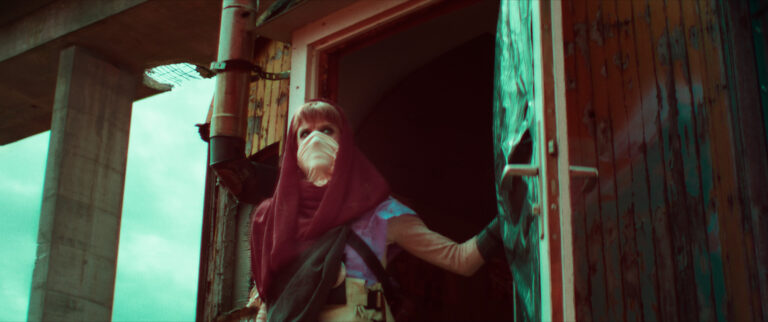
IR-Chrome material is very demanding. In most cases, the red channel is overloaded. You are forced to do a lot of post-processing, i.e. color grading. In photography you are used to this anyway (think of RAW images), whereas in the film world this is not always desired. With Full Spectrum, there’s no getting around working with a high bit rate and high bit depth. In our eyes, 10-bit is the absolute minimum. For once, it really is advisable to work with video raw-capable cameras and accept the high data rates.
The bottom line is that we got what we were looking for with IR-Chrome: An enchanting, unique visual world that offers new possibilities without the use of heavy VFX, but more or less directly in- or out-of-camera. It is true that you have to deal with this technology in great detail in order to master it, but that is precisely what motivated us to tailor our vision of the future to this technology. Even on a smaller scale, i.e. independent of ambitious climate fiction projects, Full Spectrum is a fascinating and creative technology that invites you to experiment.
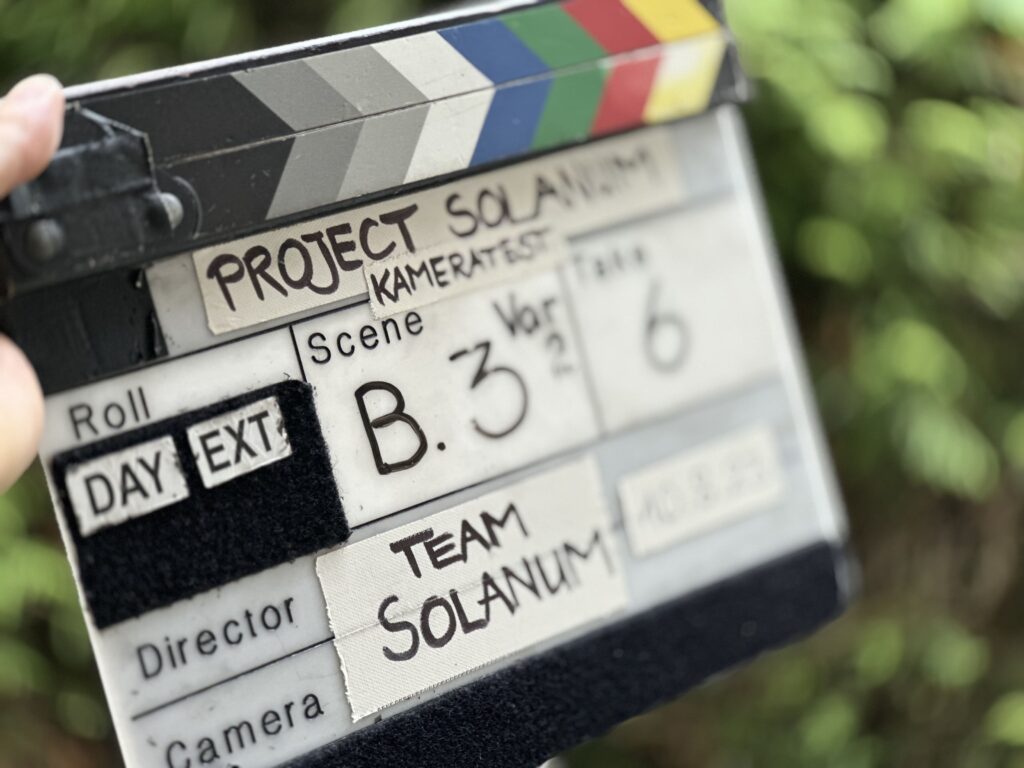
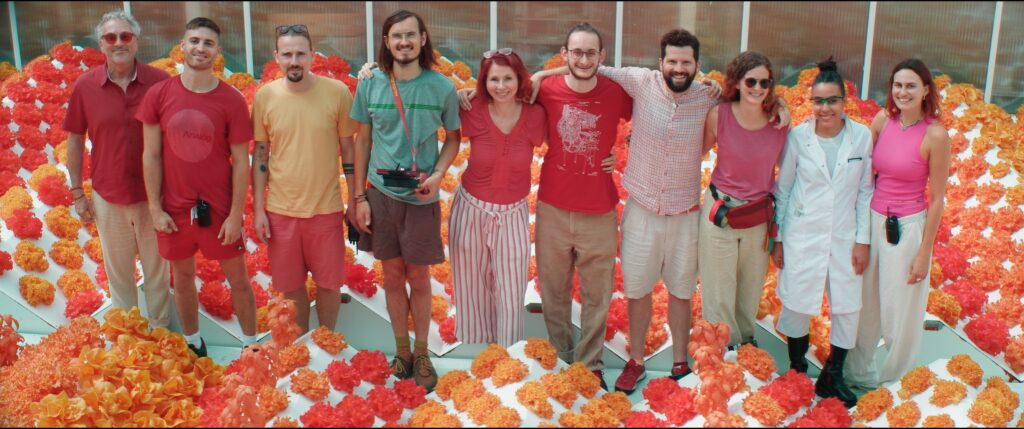
As a next step, we will also test infrared situations for scenes at night and without natural sunlight. However, not all light sources and lamps emit enough light in the infrared range. LEDs, for example, barely emit any IR light, which is why it is not possible to illuminate a set with this modern and energy-saving technology. Back to halogen and tungsten filament bulbs is the answer. These classic film lights have a very high relative infrared ratio, especially when dimmed. We are curious to see what kind of images will emerge.
Project Solanum is constantly evolving and we are on an exciting journey. You can find the current work-in-progress at our website: www.projectsolanum.ch
Kolari – Services and Equipment
Full Spectrum Conversion Service
Kolari IR Chrome Lens Filter
zumirent.ch – Equipment
Atlas Orion 2x Anamorphic Lenses
Bright Tangerine Mattebox
Teradek Bolt 500 Video Wireless Link
Atomos Sumo Director’s Monitor
IRND Filter Set 4×5.65
Radios
Our Own Equipment
BMPCC 6K (Full Spectrum converted)
Shoulder Rig
Nucleus M Follow Focus
Small HD Cine 7
Small HD Indie 7
Crew
Project Solanum – A story in development
by Sean Wirz, Carlo El Basbasi, Basil Oberli
with Marie Popall and Sasha Melroch
Camera: Basil Oberli
1st AC: Jasper ter Mors
2nd AC: Nadine Aeschbacher
Colorist: Nicolas Minder
VFX: Lukas Bieri
BTS: Mikael Zwahlen
Makeup: Sharon Berger, Ania Couderc
Costume: Gaelle Da Costa
Sound: Duri Wirz
Music: Jan Glauser
Producer: Carlo El Basbasi
Written and directed by Sean Wirz




